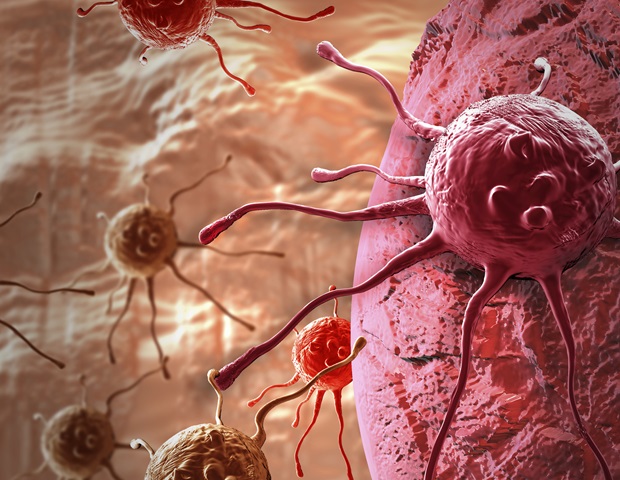Sarit – fourth in SJM Macao Open, tied 11th in the Jakarta International Championship and tied ninth in Mercuries Taiwan Masters in his previous three starts on the Asian Tour – started on the back nine and made four birdies on his way out,…
Blog
-

Artificial intelligence-assisted colonoscopy improves adenoma detection rates in routine colonoscopy practice: a single-center, retrospective, propensity score-matched study with concurrent controls | BMC Gastroenterology
This study aimed to evaluate the effectiveness of AI-assisted colonoscopy in a real-world setting. AI-assisted colonoscopy resulted in significantly higher ADRs and APCs compared to standard colonoscopy (ADR, 35.9% vs. 26.4%; APC, 0.69 vs. 0.43)….
Continue Reading
-
Evolutionary diversification and expressional profile of adrenergic receptors in the Pacific oyster Crassostrea gigas | BMC Genomics
Motiejunaite J, Amar L, Vidal-Petiot E. Adrenergic receptors and cardiovascular effects of catecholamines. Ann Endocrinol. 2021;82:193–7.
Nikishchenko V, Kolotukhina N, Dyachuk V. Comparative…
Continue Reading
-
US sanctions Russian oil majors over Ukraine, prompting India jitters and Moscow fury – Reuters
- US sanctions Russian oil majors over Ukraine, prompting India jitters and Moscow fury Reuters
- US sanctions Russian oil companies after failed Putin talks BBC
- Live updates: US sanctions on Russia over Ukraine add pressure on Putin to end war CNN
Continue Reading
-

‘She changed ballet’: Misty Copeland takes her final bow at retirement show | Ballet
Misty Copeland took one last spin on her pointe shoes Wednesday night, showered with golden glitter and bouquets as she retired from American Ballet Theatre after a trailblazing career in which she became an ambassador for diversity in an…
Continue Reading
-

Amazon apologises to customers impacted by huge AWS outage
Amazon Web Services (AWS) has apologised to customers impacted by Monday’s massive outage, after it knocked some of the world’s largest platforms offline.
Snapchat, Reddit and Lloyds Bank were among more than 1,000 sites and services reported to have gone down as a result of issues at the heart of the cloud computing giant’s operations in North Virginia, US on 20 October.
In a detailed summary of what caused the outage, Amazon said it occurred as a result of errors which meant its internal systems could not connect websites with the IP addresses computers use to find them.
“We apologise for the impact this event caused our customers,” the company said.
“We know how critical our services are to our customers, their applications and end users, and their businesses.
“We know this event impacted many customers in significant ways.”
While many platforms such as the online games Roblox and Fortnite were back up and running within a few hours of the outage, some services experienced prolonged downtime.
This included Lloyds Bank, with some customers experiencing issues until mid-afternoon, as well as US payments app Venmo and social media site Reddit.
The outage had a far-reaching impact – even reportedly disrupting the sleep of some smart bed owners.
Eight Sleep, which makes sleep “pods” with temperature and elevation options requiring an internet connection, said it would work to “outage-proof” its mattresses after some overheated and even got stuck in an inclined position.
Many experts said the outage showed how reliant tech is on Amazon’s dominance in the cloud computing sector, as a market largely cornered by AWS and Microsoft Azure.
The company said it would also “do everything we can” to learn from the event and improve its availability.
In its lengthy summary of Monday’s outage, Amazon said it came down to an issue in US-EAST-1 – its largest cluster of data centres which power much of the internet.
Critical processes in the region’s database which stores and manages the Domain Name System (DNS) records, allowing website URLs to be understood by computers, effectively fell out of sync.
According to Amazon, this triggered a “latent race condition” – or in other words unearthed a dormant bug that could occur in an unlikely sequence of events.
The delay in one process, which Amazon said occurred in the early hours of Monday morning, had a knock-on effect which caused its systems to stop working properly.
Much of this process is automated, meaning it is done without human involvement.
Dr Junade Ali, a software engineer and fellow at the Institute for Engineering and Technology, told the BBC “faulty automation” had been at the core of Amazon’s problems.
“The specific technical reason is a faulty automation broke the internal ‘address book’ systems in that region rely upon,” he said.
“So they couldn’t find one of the other key systems.”
Like others, Dr Ali believes it highlights the need for companies to be more resilient and diversify their cloud service providers “so they can fail over to other data centres and providers when one isn’t available”.
“In this instance, those who had a single point of failure in this Amazon region were susceptible to being taken offline,” he said.
Continue Reading
-

Drug shows striking success in treating children with multi-metastatic Ewing sarcoma
Ewing sarcoma is one of the most common bone cancers seen in children, and if it spreads, it can be deadly. One study found that under a quarter of children with multi-metastatic Ewing sarcoma survived five years after their…
Continue Reading
-

Stablecoin-related yields: some regulatory approaches
FSI Briefs
|
No
27
|23 October 2025
Highlights
- Some cryptoasset service providers (CASPs) offer yield-bearing products based on payment stablecoins, even though these stablecoins are not inherently designed to generate on-chain returns to holders. Yield generation often involves re-lending to borrowers, margin pools, arbitrage/derivatives collateral or facilitating their use in decentralised finance (DeFi) lending protocols. In other cases, yields are provided through loyalty programmes that are directly funded by CASPs.
- These practices may blur the lines between payment instruments and investment products. They may compete with bank deposits but are often provided without equivalent prudential oversight, deposit insurance and transparency, exposing users to consumer protection gaps and losses.
- Yield-bearing products based on stablecoins can exacerbate some general risks that stablecoins pose, for example, those related to their runnability and interaction with traditional banks. Multifunction CASPs that conduct yield-bearing lending, custody and other activities can create operational interdependencies and trigger conflicts of interest.
- Regulatory approaches to stablecoin-related yields differ across jurisdictions. Payment stablecoin issuers are uniformly prohibited from remunerating balances. CASP-provided yields, however, are subject to three different approaches: (i) complete prohibitions; (ii) restricted prohibitions that ban products for retail users and set conditions for professional investors; and (iii) no explicit prohibition.
- Addressing the risks posed by these arrangements may require a framework that extends beyond issuers to cover CASPs’ stablecoin-related activities, close regulatory gaps and safeguard end users’ protection and financial stability.
The views expressed in this publication are those of the authors and not necessarily those of the BIS.
Continue Reading
-

Innovative high-voltage system in the Cayenne Electric: performance meets efficiency
The all-electric Cayenne will soon be added to Porsche’s SUV portfolio. It is based on an evolution of the Premium Platform Electric (PPE) developed in-house. Its 800-volt architecture creates the basis for impressive charging power, intelligent energy distribution and high efficiency.
In combination with the new drive system, the Cayenne Electric achieves range figures equally suitable for everyday use and long-distance journeys. According to the combined WLTP standard, the new SUV will have a range of more than 600 kilometres. The Cayenne Electric has recently proven its long-distance capability at a consistently high average speed under real-world conditions. Several independent US journalists subjected near-production but still camouflaged prototypes to a highway range test and drove more than 350 miles (563 km) on a single battery charge at a maximum permitted speed of 70 mph (113 km/h).
This range is the result of the combination of innovative technology and sophisticated energy management. “With the Cayenne Electric, we are taking e-performance to a new level,” explains Dr Michael Steiner, Deputy Chairman of the Executive Board and Member of the Executive Board, Research and Development. “Our innovative high-voltage system combines maximum efficiency with the driving dynamics typical of Porsche.”
Integrated HV battery: safe, compact, efficient
At the heart of the Cayenne Electric is a function-integrated high-voltage battery with a gross energy content of 113 kWh. It is directly integrated into the vehicle structure and, in addition to storing energy, also acts as an integral structural component. This results in significant advantages in weight and packaging; the ratio between cells and battery housing has improved by 12 per cent compared to the second-generation Taycan battery. Integration of the battery into the body structure also increases vehicle rigidity and further lowers the car’s centre of gravity – both essential factors for driving dynamics and precision. The battery therefore contributes to the agile handling of the Cayenne Electric. Porsche is also setting new standards in the field of passive safety; the battery modules are made of a specially developed aluminium profile that absorbs energy in a targeted manner and protects the cells in the event of an impact.
Cell chemistry and energy density: peak efficiency
For maximum energy density and charging capability, Porsche uses a lithium-ion battery with six interchangeable modules and 192 large-format pouch cells. The cells consist of a graphite-silicon anode and a nickel-manganese-cobalt-aluminium cathode (NMCA). The high nickel content of 86 per cent ensures maximum energy density, while silicon in the anode significantly enhances the fast-charging capability. Aluminium increases the rigidity of the cell structure. The result: seven per cent higher energy density compared to the current Taycan battery, while also increasing charging efficiency.
Double-sided cooling: the key to sustained performance
A key element of the high-voltage system is the innovative cooling system, which regulates the temperature of the battery from both above and below. This dual cooling allows precise control of the temperature window and ensures that the battery always operates in the optimal range – regardless of the weather, charging power or driving style. The cooling capacity corresponds to that of about 100 large household refrigerators. For the first time, energy-efficient pressure fans will be used, which consume around 15 per cent less energy than conventional suction fans. The result is a consistently high charging capacity and high performance with minimal energy loss – a key element of the overall efficiency of the new Cayenne.
Predictive thermal management: thinking ahead
The new Predictive Thermal Management is an integral part of the electrical architecture of the Cayenne Electric. It links all of the vehicle’s cooling and heating circuits, continuously analyses temperature, route and driving profile, and proactively controls the flow of energy. While driving, intelligent software calculates the heating or cooling requirements in real time – taking into account navigation data, topography, traffic conditions and driving behaviour. The aim is to keep the battery in the optimum temperature window at all times – for maximum charging speed, service life and range consistency. The advantages for the driver include shorter charging times, lower energy consumption and even more accurate range predictions. The system works closely with the further-developed Charging Planner, which takes individual charging preferences into account and preconditions the battery for the next stop while driving.
“The function-integrated battery, the double-sided cooling concept and the predictive thermal management demonstrate how we think comprehensively about technology,” says Dr Michael Steiner. “Our aim is to provide electric mobility in a way that befits Porsche – efficient, powerful and engaging at the same time.”
Robust fast-charging behaviour: next-level usability
The Cayenne Electric sets new standards in charging performance. Its capacity of up to 400 kW at suitable high-power charging stations enables charging from 10 to 80 per cent in less than 16 minutes. More than 300 km of range can be added in just 10 minutes. The Cayenne Electric maintains this high level of charging power over an exceptionally wide state of charge band. Up to about 50 per cent SoC, the charging rate consistently remains between 350 and 400 kW – a clear benefit for long-distance driving.
This optimal fast-charging curve is achievable from a battery temperature of just 15 degrees Celsius, which is significantly lower than before. This means that the car’s charging performance is particularly robust under real-world conditions throughout the year. In addition, the 800-volt architecture combined with the high-voltage switch in the battery also enables efficient charging at 400-volt stations at up to 200 kW – without an additional booster.
Porsche Wireless Charging: cable-free convenience
From 2026, Porsche will offer the new Porsche Wireless Charging system – an 11 kW wireless charging system with a compact one-box floor plate – for the first time with the Cayenne Electric. This contactless charging technology achieves a similar efficiency to wired AC charging: up to 90 per cent. When parked over it, the vehicle automatically detects the floor plate and lowers itself slightly for charging. The inductive charging process takes place across a gap of a few centimetres. The entire process is fully automatic, safe and maintenance-free. The My Porsche app can be used to monitor charging processes, define time slots or authenticate several vehicles. With this technology, Porsche is once again emphasising that efficiency and convenience go hand in hand – even when charging.
“Enter Electric!“
The Volkswagen Group invites you to find out much more about electromobility with a cross-brand communication campaign. You can find more information about electromobility at Porsche on this Newsroom microsite.
Continue Reading
-

What are the Challenges of Racing at Altitude? – Atlassian Williams Racing
- What are the Challenges of Racing at Altitude? Atlassian Williams Racing
- The ultimate fan guide to the Mexico City Grand Prix Formula 1
- Will tyre plan which failed in Austin work this weekend? Five Mexican GP talking points RaceFans
- Formula 1…
Continue Reading
